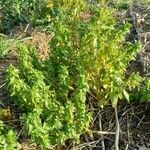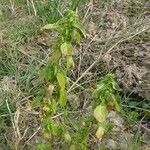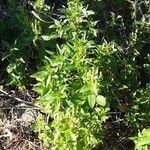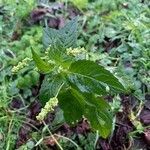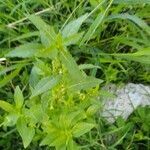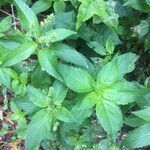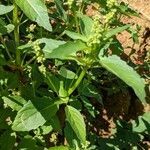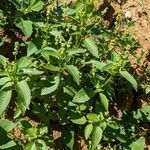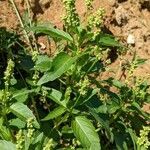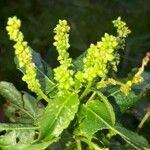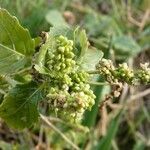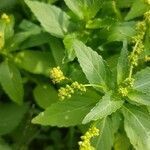Erect, ± glabrous, annual herb, usually dioecious. Stems ribbed, much-branched, up to c. 50 cm high. Lvs ovate or narrowly elliptic, acute, (1)-2-6-(8) cm long; margins crenate and finely ciliate; petiole < lf blade; stipules 4 per node, subulate or triangular, 1-2 mm long. Fls shortly pedicellate; ♂ fls clustered on long pendulous spikes; ♀ fls solitary or clustered on short spikes (spikes of some plants monoecious); perianth segments ovate-triangular, acute. Capsule hispid, smooth, deeply grooved between cells. Seeds ovoid, rounded, rugulose or smooth, brown, c. 2 mm long.
A short herb. It is usually without hairs. The stems branch from the base. The leaves are opposite and oval or sword shaped. They have short stalks and have teeth along the edge. Male and female flowers are on separate plants. The male flowers are in upright stalked spikes. They are green. The female flowers are few and in small clusters at the side. They are 3-4 mm wide. The fruit have lobes and are 2-3 mm long. They have bristles.
Annual herb to 60 cm tall, erect, glabrous; stems ribbed. Leaves: petiole 2–15 mm long, c. 0.5 mm wide; lamina elliptic to ovate, 15–70 mm long, 1.5–4 mm wide; base rounded; margins crenate-serrate with 7 or 8 teeth; tip acute. Male flowers clustered, sepals 1–1.5 mm long, stamens 8–15, free. Female flowers subsessile, sepals triangular-ovate. Fruit subglobose, 2–3 mm long, 3–4 mm wide. Seeds ovoid, c. 2 mm long.
Spreading or ascending annual, 1–5 dm; lvs lanceolate to lance-ovate, 3–6 cm, serrate; staminate spikes exceeding the lvs; fr hirsute; 2n=16 and multiples. Native of Europe, w. Asia, and n. Afr., escaped or adventive in waste places here and there in our range and s. May–Sept.
